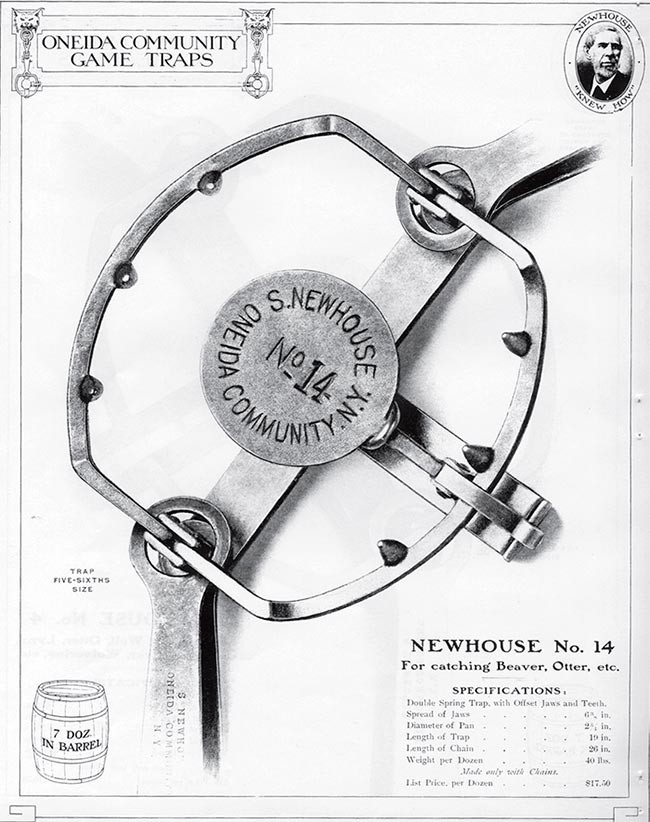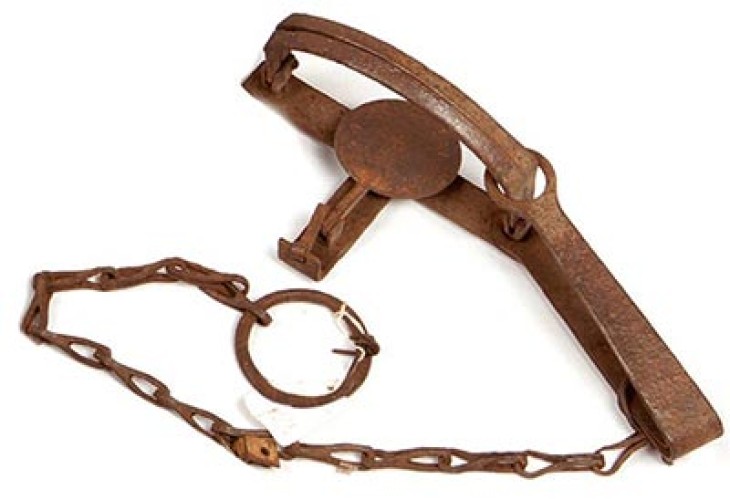Don Wharton’s piece on Adirondack mountain men got us wondering about the history of the foothold trap in America. So we looked into things and learned that while the fur trade was a huge part of colonial American commerce, most of the fur that was taken before 1800 was trapped by Native Americans using primitive means, such as snares, deadfalls, and nets. While Europeans had been using metal traps at least as far back as the middle ages – Pietro de’ Crescenzi, a chronicler of rural life in thirteenth century Italy, describes traps that “are of such a shape or form that unless they have been seen they cannot be understood” – they were, for the most part, crude devices that farmers used to control predators or rats.
As America organized itself, blacksmiths began improvising on European designs and making specialized traps designed specifically for the trapping industry. One such blacksmith was Sewell Newhouse, who was born in Brattleboro, Vermont, in 1806 and moved to Oneida County, New York, when he was 14. Newhouse learned how to temper steel from a family friend, and for the next 20 years he carved out a niche for himself as a prolific trapmaker and a woodsman of some note.
In 1849, Newhouse got hooked up with John Humphrey Noyes, a charismatic preacher who’d just started a religious commune outside of Kenwood, New York. The Oneida Community, as it was known, had a belief system based around eschewing personal property and possessions in favor of communitarianism. Looking back, some of the commune’s practices were admirably progressive – specifically their notions of gender equality. But others were downright creepy. Noyes advocated “complex marriage,” which meant that all members were encouraged to have sex with other members and to raise one another’s kids. Elders served as sexual mentors to adolescents, and Noyes oversaw a eugenics-style program where the powers that be orchestrated human partnerships the way a farmer might orchestrate relations amongst cattle.
Anyhow, Noyes told Newhouse about his commune and Newhouse said: “Sign me up!” Soon, the trapmaker had a little shop and three helpers, then more, then many more. Newhouse remained “primarily a woodsman in manner and habits, and . . . though he was always a loyal member, he went pretty much his own way” – that quote from a book on the commune by Walter Edmonds. But under Noyes’ leadership, the trapmaking business exploded. Men, women, and children from the commune worked making traps, and in less than a decade the shop had become a factory. By 1872 it was using 300,000 pounds of iron and steel to make more than 200,000 traps a year. Traps became available at every local department store around America, and trapping went from being a niche industry dominated by natives and mountain men to something anyone could do. The Oneida community became fabulously wealthy – their communal mansion is today a National Historic Landmark.
By 1879, the commune was failing; older members were dying off and the younger ones wanted traditional marriages. Noyes, the founder, got tipped off that he was wanted by the cops for statutory rape, so he fled the country in the middle of the night and later wrote a letter to his followers advising them to ditch the complex marriage part of his philosophy.
The community splintered, and in 1881 some of the members reorganized as a joint stock company called Oneida Community, Ltd. The company stopped making traps in 1912 and shifted its focus to silverware; the Newhouse name and assets were sold to the Animal Trap Company of America in Lititz, Pennsylvania. The silverware company still exists under the name Oneida Limited, though it ceased all U.S. manufacturing operations in 2005.
Newhouse continued to oversee the trapmaking at Oneida long after he was too old to wield a smith’s hammer. In his book on the history of traps, Arthur Harding says of Newhouse: “With the eye of a lynx he was ever alert to see that no trap bearing his name went out of the factory except in perfect condition. Here before he left this world for his long, long rest he trained a number of men to continue the business with the same painstaking spirit he had so long maintained.”




